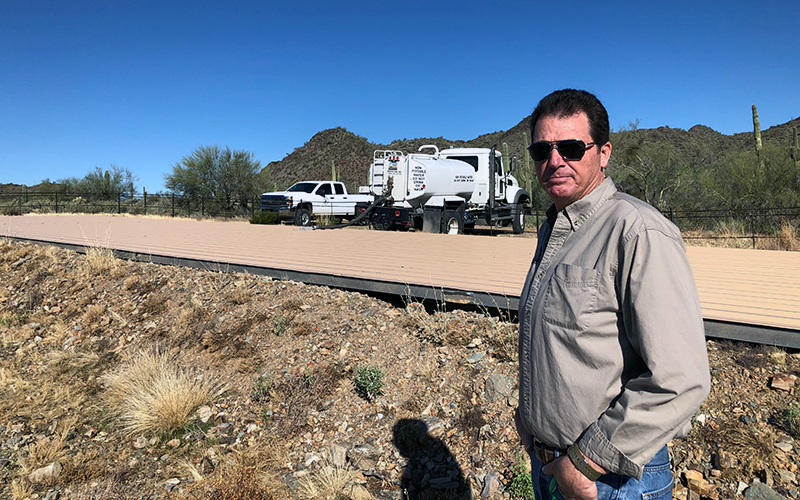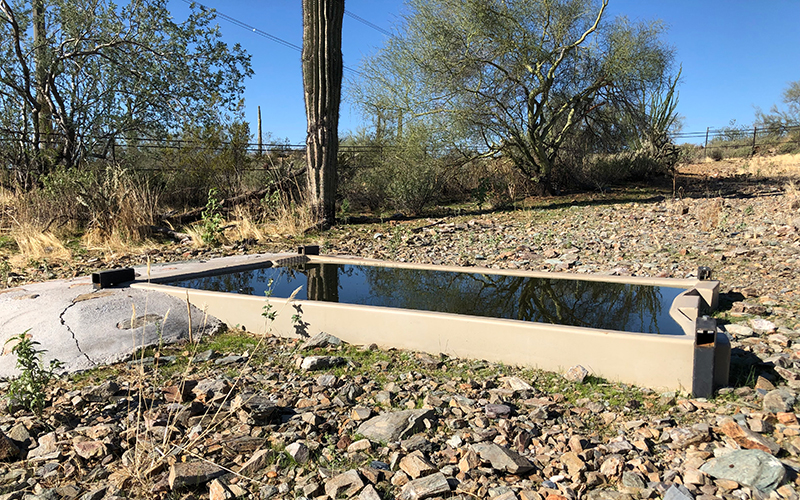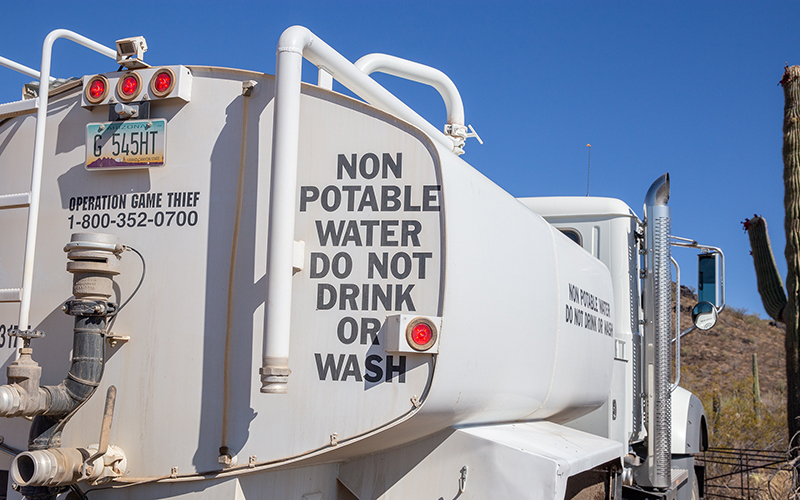PEORIA – A steady, high-pitched beep reverberates off rugged hillsides as a tanker truck backs up to a sheet of corrugated metal that’s enclosed by a small metal fence. The tanker carries nearly 1,700 gallons of Earth’s most precious resource: water.
Just west of the Arizona Game & Fish Department’s headquarters along Carefree Highway, one of the state’s nearly 3,000 wildlife water catchments sits amid creosote, palo verde and saguaros.
Catchments are man-made watering facilities that sustain animals during hot and dry periods. Wildlife use them year-round.
Joseph “Joe” Currie is responsible for making sure all the catchments across the state are well-maintained. Over his 22 seasons with Arizona Game & Fish, Currie has spent the past 13 working on, and now supervising, water for wildlife.
“It’s actually been very important for stabilizing the population of wildlife in Arizona,” he said. “If we didn’t have the water out there, we’d witness really drastic fluctuations in the population.”
Game & Fish monitors about 1,000 of its own catchments and maintains 1,000 for the Bureau of Land Management and another 1,000 for the U.S. Forest Service. Currie said the program in Arizona goes back at least since the 1940s, beginning as an effort to support game birds.
“The first ones (catchments) were called ‘gallinaceous guzzlers,’ and the gallinaceous is the family name for quail,” he said. “So they were quail waters, they were really targeting quail and small-game type of things.”
However, the lure of water in the desert proved irresistible to animals much larger than quail.
“The deer were coming in, javelina and bobcats, mountain lions, you name it.” Currie said. “So they quickly changed the design to help out all wildlife to be able to access the water and drink from them.”
New technology and gradual innovation have led to a dramatic shift between how catchments operated 80 years ago and how they operate now. Game & Fish has delivered more than 1.5 million gallons of water since January 2018.

Nate Solomon is in charge of the small team that refills and maintains catchments, some of which can be accessed only by helicopter. Before he started working on catchments nearly five years ago, Solomon had never been in a helicopter. “It’s even more exciting because there’s not a lot of places to land on a mountain, you know, right? But yeah, you get used to it,” he said. (Photo by Jonah Hrkal/Cronkite News)
Getting water to remote places
Once the tanker truck is in position, the desert falls quiet except for the slam of the truck’s door. Nate Solomon pulls a hose from the back of the truck, places it in the middle of the corrugated sheet and opens a valve to start the flow. Solomon is the habitat enhancement field crew supervisor for Arizona Game & Fish, and his small crew is tasked with keeping these catchments full and repairing and maintaining them as needed.
Solomon spends a good amount of his time driving a water truck, which takes him to some of the state’s most remote parts. The team works a schedule of eight days on and six days off.
“And we camp 99 percent of the time,” Solomon said. “We basically tent it. Cot it. Sleeping bag it for eight days. And when we’re really overloaded and they need extra help, I’ll go out with them.”
These trips often involve custom built water tankers with beefier axles and tires, as well as higher ground clearance.
“And they’re four-wheel drive, which most water trucks aren’t,” Solomon added.
But land vehicles can’t go everywhere, which is why Game & Fish uses helicopters to airlift water to certain wildlife catchments.
“In the summertime, we do a lot of helicopter work,” Solomon said. “Especially the (big horn) sheep catchments that are way up on a mountain; there’s no road access.”

Joe Currie has worked at the Arizona Game & Fish Department for 22 years, the past 13 as program manager of the water catchment program. He’s responsible for more than 3,000 catchments across the state. (Photo by Jonah Hrkal/Cronkite News)
A costly endeavor
From truck repairs to paying for emergency water drops, the costs continue to mount for Arizona Game & Fish. The department’s baseline budget of about $500,000 covers operations and management of the catchments, and care of the vehicle fleet.
Game & Fish does not receive dollars from the state’s general fund. Sometimes the department turns to the public for help. Public funding is very important to those who manage the catchments. Without these contributions, Currie worries the program could slow down.
“They would definitely get less done; the wildlife waters are too important to the public to ever stop,” he said. “But never say never.”
Last year, the department started its Water for Wildlife donation campaign to address the rising costs associated with providing life-sustaining water.
For Currie, the state’s vast number of catchments aren’t just meant for wildlife. They’re meant for people, too, places where they can observe wildlife in their natural habitat – watering holes for all.
“It’s kind of fun to look for these. I’ve had people that said they’ve been all over Arizona, and I’ve never actually seen one of these,” Currie said. “But then they finally saw us working on one and came up and went, ‘Wow, I didn’t even know these are out there. And it’s so cool to see.'”



